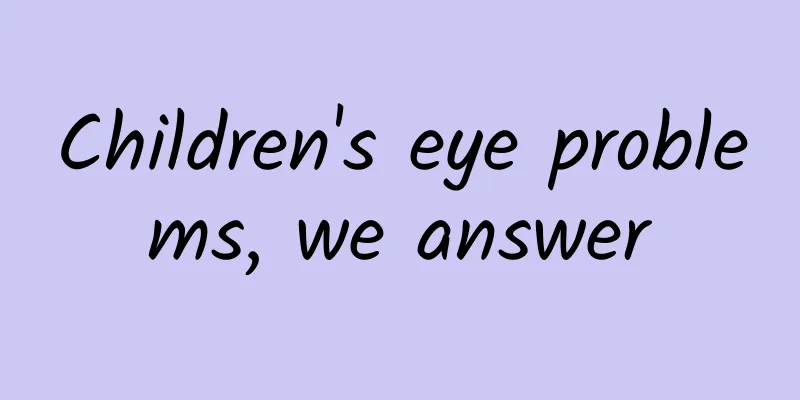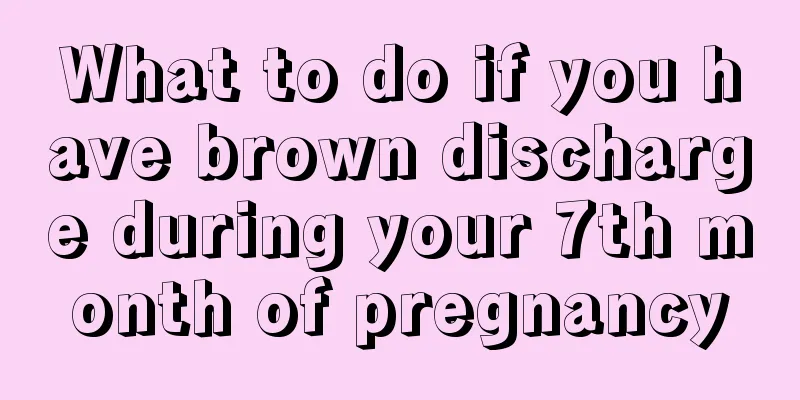Children's eye problems, we answer

|
Author: Qian Chen Children's Hospital Affiliated to Fudan University Reviewer: Yang Chenhao, Chief Physician, Children's Hospital Affiliated to Fudan University Children's eye health and vision problems have always been a topic of concern and heated discussion among society and parents. Here are 5 common questions, and we will answer them one by one. Question 1: What eye problems should we pay attention to during infancy and childhood? Answer : If parents find that their children have abnormal eye appearance or visual behavior, they should go to the hospital for examination as soon as possible. 1. Abnormal eye appearance: such as strabismus or abnormal eye movement, abnormal yellow-white reflection in the pupil area, drooping eyelids, persistent tearing or excessive secretions in the eyes, etc. Figure 1 Copyright image, no permission to reprint 2. Abnormal visual behavior : If the child walks unsteadily, falls easily, is insensitive to color discrimination, easily falls in dark environments, resists covering one eye or squints, tilts the head, looks closely, cannot make eye contact with others, and other abnormal conditions, an eye examination should be conducted promptly. Question 2: What eye examinations should children undergo when they come to the hospital? Answer : After the doctor makes a preliminary judgment, he will conduct a targeted eye examination, mainly including the structural examination of the anterior segment of the eye (such as cornea, lens, etc.) and the posterior segment of the eye (such as retina, optic nerve, etc.). If the child cooperates, relevant examinations such as vision, eye position, refractive state, eye axis, corneal topography, and visual electrophysiology will also be conducted. The eyes not only have the function of "seeing", but also have stereoscopic vision functions such as judging depth. Therefore, binocular vision function examination is also required when necessary. Figure 2 Copyright image, no permission to reprint Question 3: What preparations do parents need to make before an eye examination? Answer : Parents should comfort and educate their children. Children may be nervous, afraid, or even cry when they come to the hospital, so you can simulate scenarios such as covering your eyes and following the flashlight at home in advance to relieve your child's nervousness and anxiety. Eye examinations are basically non-invasive, non-contact, and painless. If the child cooperates, accurate examination results can be obtained and the examination efficiency is high. For children over 3 years old, parents can teach their children to recognize the "E" eye chart or graphic sight mark in advance before coming to the hospital for examination, so that the doctor can intuitively understand the child's vision development. Figure 3 Copyright image, no permission to reprint Question 4: If a child’s vision test does not meet the standards, is it necessary to perform “mydriasis refraction”? Answer : Children have strong eye adjustment ability. Mydriatic eye drops can paralyze the ciliary muscles of the eyes, so that the eye refraction is not affected by adjustment factors, thus measuring the child's true and accurate refraction. The doctor will judge whether the child has amblyopia and whether he needs to wear glasses based on the child's age, eye position, refraction after mydriasis and corrected vision. Therefore, "mydriasis refraction" is very necessary, and mydriasis does not harm the eyes. Question 5: How often do children who wear glasses need to have their glasses checked and replaced? Answer : Children are in a period of rapid development, and their vision and refraction change rapidly. Glasses not only help the eyes see clearly, but also play a therapeutic role. Therefore, children who wear glasses generally need regular checkups every 3 months or so. After they are relatively stable, they generally need to be checked every 6 months. The cycle of changing glasses is not absolutely fixed. It should be determined based on the child's vision, eye position, eye axis, refractive power changes after mydriasis, binocular vision function, etc. In addition, factors such as whether the lens is worn, whether the frame is deformed, and changes in the child's pupil distance should also be considered to comprehensively decide whether new glasses need to be replaced. Normally, children need to replace their glasses once a year or so. Figure 4 Copyright image, no permission to reprint Two suggestions for children's eye health issues. Recommendation 1 : Premature babies have many eye problems, so fundus screening is a must. The retinal blood vessels of premature infants are not yet fully developed, and they may develop retinopathy of prematurity, which can cause blindness in severe cases. Therefore, premature infants should undergo fundus examinations as prescribed by doctors a few weeks after birth, and regular follow-up examinations are required. In addition, premature infants are more likely to develop myopia, strabismus and other problems than normal full-term infants. After fundus screening, they also need regular ophthalmological examinations so that early intervention and treatment can be carried out if problems are found. Figure 5 Copyright image, no permission to reprint Suggestion 2 : Develop good eye habits from an early age As the first person responsible, parents should cultivate good eye habits in their children from an early age. Children should follow the "20-20-20 eye protection rule" when using their eyes, that is, after using their eyes at close range for 20 minutes, they should look 20 feet (6 meters) away for at least 20 seconds. At the same time, pay attention to your posture when reading and writing. Keep your eyes at least 30 cm away from the book, sit upright, one fist away from the desk, and hold the pen with your fingers 3 cm. Usually, accompany your children to participate in outdoor activities and cultivate their interest in outdoor sports, so as to achieve the effect of "eyes" bathing in the sun. At the same time, pay attention to observe some abnormal manifestations of the child's eyes. Once the child looks at things close, tilts his head, squints, or squints, he should go to the hospital for examination as soon as possible. As Eye Care Day approaches, I sincerely wish every child can have bright eyes and a bright future! |
<<: Will varicocele cause the left testicle to be smaller and the right testicle to be larger?
>>: Treat intestinal polyps early to prevent them from turning into rectal cancer
Recommend
Why do women urinate more frequently at night?
Frequent urination is very common in life. Genera...
What to do if you have a cough during pregnancy
As we all know, pregnancy is a particularly diffi...
Self-exercise of respiratory function after COVID-19 infection
The rapid spread of the new strain "Delta&qu...
A little drinking can make you happy, but drunkenness can harm your health - lies at the drinking table
This is the 4485th article of Da Yi Xiao Hu Durin...
Is the appendix on the left or right?
People who have never had appendicitis often ask ...
Is it normal to stop bleeding the next day after a painless abortion?
Painless abortion is very harmful to the body, be...
What causes low white blood cell count in pregnant women?
During pregnancy, the physical condition of pregn...
Taboos for pregnant women to eat black beans
Everyone has heard of black beans. This is a food...
Can pregnant women drink mung bean porridge?
Pregnant women need to pay attention to their die...
How to remove blackheads and enlarged pores
When the seasons change, the skin alternates betw...
What are the treatments for adenomyomatosis?
Different diseases have different stages of devel...
What is the normal range of amniotic fluid index?
Too much or too little amniotic fluid is not good...
Girl's left hip pain
The key reasons for women's left buttock pain...
Cervical biopsy p16
There are actually many items in gynecological ex...
What causes vaginal bleeding after running?
Compared with men, women have more things to pay ...









